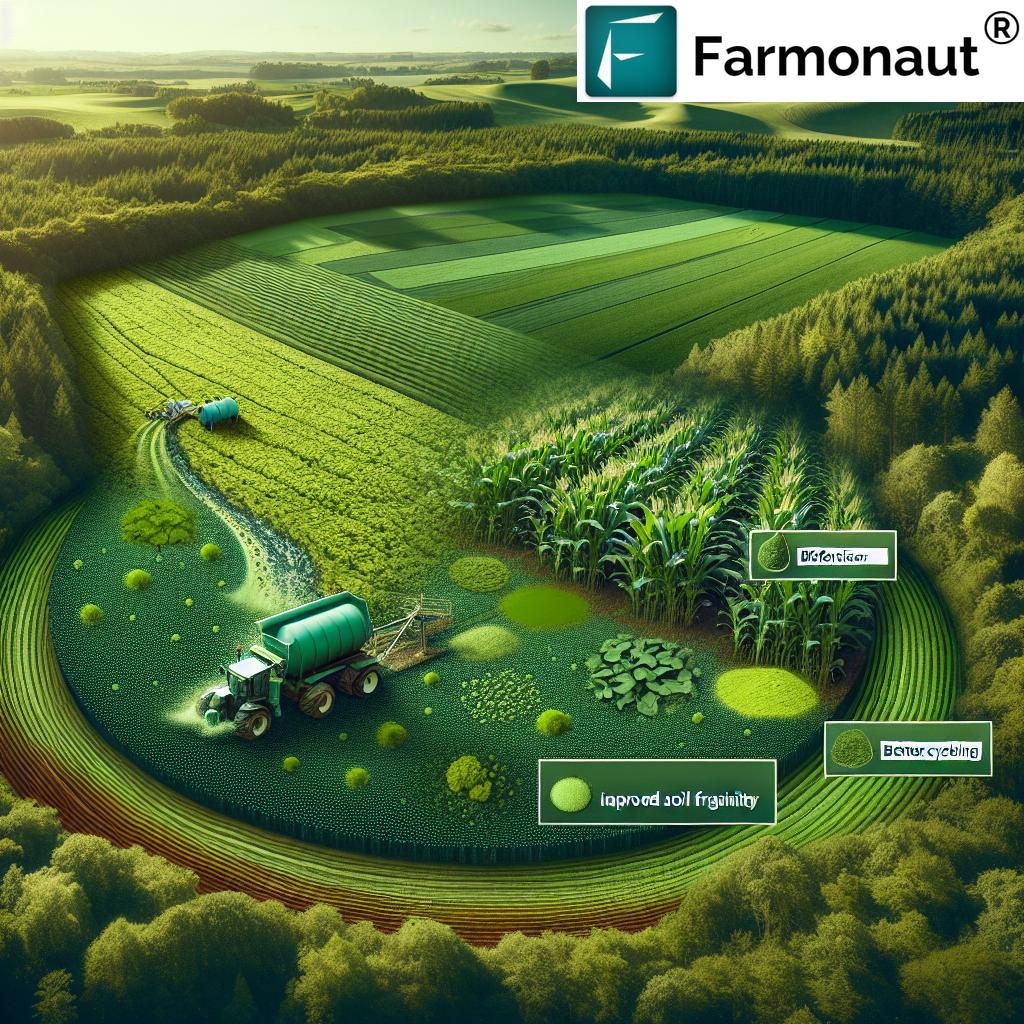“In 2025, regenerative agriculture could improve soil organic matter by up to 21% compared to conventional farming.”
Regenerative Agriculture: 7 Ways for Sustainable Farming
As global challenges like climate change, soil degradation, and biodiversity loss intensify, the agricultural sector is undergoing a vital transformation in 2025. Regenerative agriculture has emerged as a beacon of hope—transforming farming from a system that often depletes natural resources into one that restores, rebuilds, and enhances the land.
This article explores the science, methods, and positive ripple effects of regenerative agriculture, focusing on seven transformative ways this approach is shaping modern farming systems. We’ll detail how agriculture regenerative moves beyond traditional organic practices to actively boost soil health, sequester carbon, and contribute to truly sustainable food production—benefiting farmers, consumers, and the planet.
Core Principles of Regenerative Agriculture
At its core, regenerative agriculture is an approach that emphasizes restoring and rebuilding vital natural resources such as soil health, water retention, and biodiversity. It goes beyond the absence of chemicals (organic) to focus on actively enhancing ecological resilience and ecosystem functions that conventional agriculture often depletes.
- Soil Health as Foundation: Building rich, living soils with high organic matter, vibrant microbial activity, and protective cover.
- Biodiversity: Fostering crop diversity, cover crops, and agroforestry to support healthy food webs and pollinators.
- Water Management: Enhancing water retention and infiltration to buffer against droughts and floods.
- Carbon Sequestration: Turning soils into carbon sinks, mitigating a significant portion of agriculture’s greenhouse emissions.
- Ecosystem Service Restoration: Providing habitats, boosting yields, and supporting rural livelihoods into the future.
Regenerative agriculture farms in 2026 are integrating these principles to deliver multiple benefits—from increased productivity and resilience to improved profitability and healthy communities.
Why Regenerative Agriculture Is Essential in 2025 and Beyond
The agricultural sector is at a crossroads. Conventional farming has made abundant food possible—but with significant costs to the environment:
land degradation, water crises, and loss of biodiversity. The risks—as seen in more frequent droughts, climate change shocks, and declining ecosystem function—intensify every year.
In 2026 and beyond, the world’s growing population and the continued challenges of a changing climate demand a new kind of farming: one that enables resilient food systems, restores soils, sequesters carbon, and also boosts profitability for farmers. That’s where regenerative agriculture stands out.
- Climate Mitigation: Practices actively sequester carbon and moderate greenhouse gas emissions.
- Productivity Increases: Regenerative organic agriculture systems can increase yields and reduce input costs long-term.
- Economic Security: Healthier soils mean less risk—farmers are better equipped to act during droughts or market volatility.
- Ecosystem Resilience: Agroforestry, diversification, and direct livestock integration create balanced, stable, and adaptive farming landscapes.
Growing consumer and public interest is also pushing the transformation. Searches for “regenerative agriculture near me” reflect a shift—consumers are seeking food from farms committed to restoring the land.
Farmonaut’s affordable, satellite-powered tools provide real-time crop monitoring and soil insights so that regenerative farming can scale efficiently on large or small farms. Explore the carbon footprinting solution to accurately track carbon sequestration and emissions as part of your sustainable farm management strategy.
7 Ways to Transform Farming with Regenerative Agriculture
Regenerative agriculture farms leading the transformation in 2026 leverage seven key practices—each designed to harmonize food production with ecosystem health. Let’s dive into each method, how it works, and its real-world impact.
“Seven core regenerative practices can increase crop yields by 20% while enhancing ecosystem biodiversity.”
1. Cover Cropping
Cover crops like clover, vetch, and rye are planted between or alongside main crops—not for harvest, but for the ecosystem itself. These living plants cover and protect soil from erosion, suppress weeds, break pest cycles, and add organic matter as they decompose.
– Farms practicing cover cropping find up to 21% higher soil organic matter in 2025 vs. bare fields.
– Cover crops improve water infiltration and act as powerful carbon sinks.
– They are a keystone in organic regenerative agriculture, enhancing both soil health and yields.
2. Crop Diversification & Rotation
Monocultures deplete soil nutrients and weaken ecosystem resilience. Instead, crop diversification integrates multiple crop types—grains, legumes, vegetables, roots, and sometimes even medicinal or pollinator plants—in a dynamic, rotating system.
– This rotation interrupts pest and disease cycles, reduces the need for external chemical inputs, and supports soil microbial activity.
– Farms adopting diverse rotations have documented increased yields and significant improvements in soil structure.
– Diversification fosters biodiversity and ecological balance across seasons.
3. Reduced or No-Tillage
Tillage—frequent plowing or turning of the soil—disrupts microbial populations, increases erosion, and releases stored carbon from the soil. In contrast, regenerative farming systems minimize or entirely avoid tillage.
– No-till and low-till methods use crop residue mulch and specialized planters, keeping soil structure intact.
– This increases water retention, reduces soil erosion, and enhances carbon sequestration.
– Farms report reduced input costs and improved soil health over the long term.
4. Agroforestry & Silvopasture
Agroforestry involves the purposeful integration of trees, shrubs, and perennial plants with traditional crops and/or livestock. It mimics natural, layered forest systems, creating habitat diversity and multiple revenue streams.
– Silvopasture combines trees with grazing livestock for shade and fodder.
– These systems support biodiversity, reduce erosion, moderate microclimates, trap more carbon, and provide fruits, nuts, timber, and other products.
– Agroforestry is especially prominent in regions seeking resilient, climate-adaptive agriculture.
5. Holistic Livestock Integration
Regenerative agriculture reimagines livestock not as separate, isolated operations, but as integrated elements of the ecosystem.
– Rotational or planned grazing mimics the movement of wild herds, fertilizing and stimulating soil life.
– Managed grazing enhances carbon sequestration, reduces bare ground, boosts forage quality, and closes nutrient cycles.
– When tightly integrated, livestock promote soil vitality and support healthy ecosystems.
6. Compost & Organic Inputs
Rather than chemical fertilizers, regenerative systems prioritize organic matter inputs—compost, green manure, mulch, and biochar.
– These inputs feed soil microbes, boost soil organic carbon, and sustain nutrient cycles.
– Composting plant and animal waste locally reduces farm input costs, recycles resources, and builds fertile soils.
– This principle underpins both organic and regenerative agriculture certifications.
7. Precision Resource Management & Digital Monitoring
The future of regenerative farming in 2026 will rely on advanced, data-driven resource management—from real-time soil and crop health monitoring to blockchain traceability of sustainable food.
– Satellite and AI-driven tools, like those provided by Farmonaut, enable farmers to precisely manage inputs, water usage, crop plans, and carbon credits.
– Transparent digital records support regenerative organic agriculture certifications—boosting trust among consumers and ensuring ecosystem health can be documented and rewarded.
Discover Farmonaut’s traceability solution, built to ensure that regenerative and organic food origins are transparent, verified, and trustworthy for supply chain and consumer confidence.
Comparison Table of Regenerative Agriculture Practices and Their Estimated Environmental Impact
| Practice | Brief Description | Estimated Soil Health Improvement (% increase in soil organic matter) | Yield Impact (Crop Yields) | Environmental Benefit |
|---|---|---|---|---|
| Cover Cropping | Growing non-harvest crops to protect and enrich soil between main crops | 10–21% | +5–10% | Reduces erosion, increases carbon sequestration |
| Crop Diversification & Rotation | Alternating diverse plant species to support soil and ecosystem health | 8–18% | +5–20% | Boosts biodiversity, reduces pest cycles, lowers input needs |
| Reduced/No-Tillage | Minimizing soil disturbance to maintain structure and microbes | 12–20% | +3–8% | Reduces emissions, improves water retention, stores carbon |
| Agroforestry & Silvopasture | Integrating trees, shrubs, and livestock with crops | 12–19% | +7–15% | Stores more carbon, provides habitats, diversifies income |
| Holistic Livestock Integration | Managed grazing to mimic natural herd impact | 10–16% | +6–14% | Reduces bare ground, enhances nutrient cycling, soil health |
| Compost & Organic Inputs | Adding organic matter to feed soil microorganisms | 9–15% | +4–12% | Builds fertile soils, decreases need for synthetic fertilizer |
| Precision Resource Management | Using tech for targeted irrigation, nutrient, and carbon monitoring | Up to 21% | +5–20% | Reduces waste, optimizes water, tracks sustainability |
Farmonaut: Empowering Regenerative Agriculture with Satellite Technology
Satellite-driven agriculture is reshaping how farmers and land managers approach regenerative agriculture at every scale. At Farmonaut, we are dedicated to making satellite insights, AI-powered advisories, and blockchain-based traceability affordable and accessible for all.
Our platform supports farmers and agribusinesses by providing:
- Real-Time Monitoring: Using satellite imagery to assess soil health, crop vigor, and environmental impact anywhere worldwide.
- AI Advisory: Our Jeevn AI delivers site-specific weather insights and regenerative recommendations to enhance productivity and resilience.
- Blockchain Traceability: Record and prove organic regenerative agriculture practices to build trust with markets and consumers.
- Environmental Impact Tracking: Farmonaut enables carbon footprinting, supporting climate mitigation and sustainable certifications.
We offer solutions across web, Android, iOS, and API for seamless operation everywhere. Developers and businesses can easily integrate our satellite insights via API to build custom regenerative applications for large-scale farm management and environmental reporting.
For technical teams, our API documentation provides all the resources needed to accelerate innovation in sustainable farming.
Looking for solutions to manage vast agricultural landscapes? Farmonaut’s large-scale farm management app delivers data-driven oversight to maximize productivity, minimize resource waste, and foster long-term soil health across multiple locations.
Wider Ecosystem & Socio-Economic Benefits
The practice of regenerative agriculture does more than just increase individual farm resilience or boost crop yields. It acts as a keystone strategy for restoring degraded land, reducing environmental risk, and fostering economic security for rural communities. Specific outcomes include:
- Biodiversity Recovery: Diverse plantings, agroforestry, and cover cropping restore wildlife habitats and pollinator corridors, making farming systems more self-sustaining.
- Water Security: Regenerative soil practices enhance water retention capacity, buffer against floods and droughts, and reduce irrigation needs.
- Climate Change Mitigation: By sequestering carbon in living soil and perennial vegetation, regenerative approaches contribute significantly to international carbon reduction targets and food security strategies.
- Socio-Economic Revitalization: Sustainable farming connects local farmers, CSA programs, and consumers, building resilient local food systems and income diversity for smallholders and commercial operations alike.
Learn more about sustainable forest management and plantation strategy with Farmonaut’s crop plantation and forest advisory guidance, built for modern regenerative land management.
Banks and rural cooperatives can access Farmonaut’s crop loan and insurance verification platform to support sustainable transitions, minimize fraud, and reward ecosystem-friendly farming practices.
Policy, Market, and Consumer Trends: The 2026 Landscape
Governments and international institutions now recognize regenerative agriculture as essential for sustainable food systems and for climate adaptation. Certification schemes for regenerative organic agriculture guarantee that foods are produced without synthetic chemicals and with active environmental restoration—offering opportunities for farmers to access new markets and premium pricing in local and export channels.
- CSA and Farmer’s Markets: Features highlighting regenerative farms are now common worldwide, connecting consumers directly with food produced through soil-supportive systems.
- Consumer Search Trends: Searches for “regenerative agriculture near me” signal rising demand for transparent, restorative, and local food from sustainable farms.
- Market Incentives: Policymakers are backing ecosystem services with incentive programs—from carbon credits to resource stewardship payments for restoring land.
- Technological Integration: Digital monitoring, traceability, and blockchain-verifiable certifications (such as those supported by Farmonaut) make it easier to prove and reward ecosystem-based farming efforts.
Embracing regenerative agriculture is not just a trend—it’s a major policy priority and cultural shift for a sustainable future.
Frequently Asked Questions (FAQ) About Regenerative Agriculture
Q1. What defines regenerative agriculture?
Regenerative agriculture is a holistic farming approach that goes beyond organic by actively restoring soil health, boosting ecosystem resilience, and enhancing both food production and climate mitigation.
Q2. How does regenerative agriculture differ from organic farming?
While organic farming eliminates synthetic chemicals, regenerative agriculture not only maintains organic inputs but also restores soil, sequesters carbon, and revives ecosystem functions.
Q3. What are common regenerative practices used worldwide?
Key methods include cover cropping, diverse crop rotations, reduced/no-tillage, agroforestry, holistic livestock integration, composting, and precision resource management.
Q4. How do consumers benefit from regenerative agriculture?
Consumers gain access to healthier, transparently produced food, while supporting local and global sustainable food systems that restore rather than deplete the environment.
Q5. How do I find regenerative agriculture farms or products near me?
Search “regenerative agriculture near me” online, visit farmers’ markets, join CSA programs, and look for food with regenerative organic certifications. Many farms highlight these practices for increased consumer trust.
Q6. How does Farmonaut help regenerative farmers?
At Farmonaut, we provide real-time satellite monitoring, AI-based advisories, and digital traceability tools to empower farmers and businesses in scaling up sustainable, regenerative agriculture across diverse regions.
Q7. Can regenerative agriculture contribute to combating climate change?
Yes. Healthy soils are powerful carbon sinks, and regenerative farming enhances sequestration, reduces agricultural emissions, and builds climate resilience locally and globally.
Conclusion: The Future of Sustainable Farming with Regenerative Agriculture
Regenerative agriculture in 2026 is more than a trend—it represents a foundational shift to food systems that are productive, resilient, and climate-smart. By combining organic principles with regenerative techniques like cover cropping, agroforestry, reduced tillage, and digital resource management, farming can transition from being a source of ecological degradation to a solution for planetary health.
Communities, markets, and policymakers worldwide are supporting this movement: regenerative agriculture farms and their foods are gaining prominence, consumers are seeking restorative certifications, and digital platforms enable transparency and scalability for systemic change.
With the rise of real-time monitoring and advanced technology available via Farmonaut, the dream of transforming agriculture into a force for environmental restoration, economic security, and sustainable food for future generations is actively unfolding.
For anyone—farmer, business, or policy leader—seeking to build a resilient and profitable agricultural operation in the years ahead, embracing regenerative agriculture is not just a wise investment; it is a vital act of stewardship for the planet.










